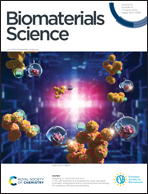Remodeling of structurally reinforced (TPU+PCL/PCL)-Hep electrospun small-diameter bilayer vascular grafts interposed in rat abdominal aortas†
Abstract
As thermoplastic polyurethane (TPU) elastomers possess good biocompatibility and mechanical properties similar to those of native vascular tissues, they were intended to be co-electrospun with poly(ε-caprolactone) (PCL) onto the outer surface of PCL electrospun small-diameter single-layer vascular grafts (SLVGs) in this study, combining with surface heparinization. In this work, a kind of structurally reinforced TPU+PCL/PCL small-diameter bilayer vascular graft (BLVG) was fabricated via layer-by-layer electrospinning followed by the heparinization of PCL via EDC/NHS chemistry. The resulting (TPU+PCL/PCL)-Hep BLVGs presented excellent mechanical strength and higher compliance, and sustainably released heparin exhibited enhanced anti-coagulation activity. During 6-month implantation in 18 rat abdominal aortas, these vascular prostheses induced the remodeling and regeneration of neovascular tissues, and promoted ECM deposition. Compared to heparinized PCL (PCL-Hep) SLVGs, the formation of aneurysm was completely inhibited and the onset of calcification was significantly delayed in (TPU+PCL/PCL)-Hep BLVGs. Not only vascular cell makers co-expressed by CD206+ cells were identified, but also a high content of elastin was evidenced due to the improvement of mechanical strength and compliance. These results indicated the feasibility and efficacy of inhibiting the aneurysm formation and boosting the vascular remodeling by incorporating TPU into PCL-Hep small-diameter artificial vascular grafts.



 Please wait while we load your content...
Please wait while we load your content...